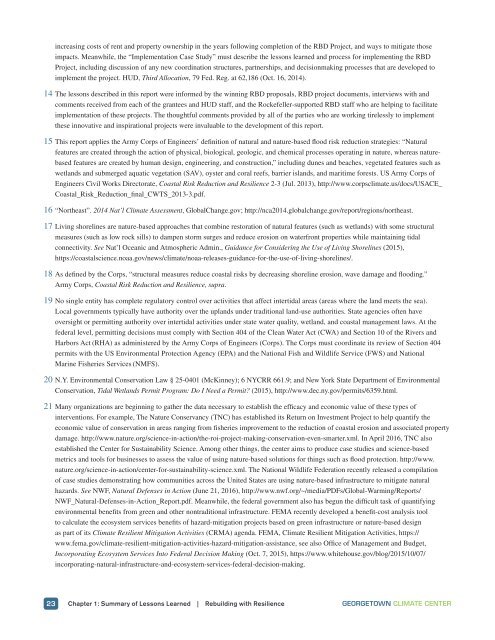Rebuilding with Resilience
dw0r306aHfX
dw0r306aHfX
You also want an ePaper? Increase the reach of your titles
YUMPU automatically turns print PDFs into web optimized ePapers that Google loves.
increasing costs of rent and property ownership in the years following completion of the RBD Project, and ways to mitigate those<br />
impacts. Meanwhile, the “Implementation Case Study” must describe the lessons learned and process for implementing the RBD<br />
Project, including discussion of any new coordination structures, partnerships, and decisionmaking processes that are developed to<br />
implement the project. HUD, Third Allocation, 79 Fed. Reg. at 62,186 (Oct. 16, 2014).<br />
14 The lessons described in this report were informed by the winning RBD proposals, RBD project documents, interviews <strong>with</strong> and<br />
comments received from each of the grantees and HUD staff, and the Rockefeller-supported RBD staff who are helping to facilitate<br />
implementation of these projects. The thoughtful comments provided by all of the parties who are working tirelessly to implement<br />
these innovative and inspirational projects were invaluable to the development of this report.<br />
15 This report applies the Army Corps of Engineers’ definition of natural and nature-based flood risk reduction strategies: “Natural<br />
features are created through the action of physical, biological, geologic, and chemical processes operating in nature, whereas naturebased<br />
features are created by human design, engineering, and construction,” including dunes and beaches, vegetated features such as<br />
wetlands and submerged aquatic vegetation (SAV), oyster and coral reefs, barrier islands, and maritime forests. US Army Corps of<br />
Engineers Civil Works Directorate, Coastal Risk Reduction and <strong>Resilience</strong> 2-3 (Jul. 2013), http://www.corpsclimate.us/docs/USACE_<br />
Coastal_Risk_Reduction_final_CWTS_2013-3.pdf.<br />
16 “Northeast”. 2014 Nat’l Climate Assessment, GlobalChange.gov; http://nca2014.globalchange.gov/report/regions/northeast.<br />
17 Living shorelines are nature-based approaches that combine restoration of natural features (such as wetlands) <strong>with</strong> some structural<br />
measures (such as low rock sills) to dampen storm surges and reduce erosion on waterfront properties while maintaining tidal<br />
connectivity. See Nat’l Oceanic and Atmospheric Admin., Guidance for Considering the Use of Living Shorelines (2015),<br />
https://coastalscience.noaa.gov/news/climate/noaa-releases-guidance-for-the-use-of-living-shorelines/.<br />
18 As defined by the Corps, “structural measures reduce coastal risks by decreasing shoreline erosion, wave damage and flooding.”<br />
Army Corps, Coastal Risk Reduction and <strong>Resilience</strong>, supra.<br />
19 No single entity has complete regulatory control over activities that affect intertidal areas (areas where the land meets the sea).<br />
Local governments typically have authority over the uplands under traditional land-use authorities. State agencies often have<br />
oversight or permitting authority over intertidal activities under state water quality, wetland, and coastal management laws. At the<br />
federal level, permitting decisions must comply <strong>with</strong> Section 404 of the Clean Water Act (CWA) and Section 10 of the Rivers and<br />
Harbors Act (RHA) as administered by the Army Corps of Engineers (Corps). The Corps must coordinate its review of Section 404<br />
permits <strong>with</strong> the US Environmental Protection Agency (EPA) and the National Fish and Wildlife Service (FWS) and National<br />
Marine Fisheries Services (NMFS).<br />
20 N.Y. Environmental Conservation Law § 25-0401 (McKinney); 6 NYCRR 661.9; and New York State Department of Environmental<br />
Conservation, Tidal Wetlands Permit Program: Do I Need a Permit? (2015), http://www.dec.ny.gov/permits/6359.html.<br />
21 Many organizations are beginning to gather the data necessary to establish the efficacy and economic value of these types of<br />
interventions. For example, The Nature Conservancy (TNC) has established its Return on Investment Project to help quantify the<br />
economic value of conservation in areas ranging from fisheries improvement to the reduction of coastal erosion and associated property<br />
damage. http://www.nature.org/science-in-action/the-roi-project-making-conservation-even-smarter.xml. In April 2016, TNC also<br />
established the Center for Sustainability Science. Among other things, the center aims to produce case studies and science-based<br />
metrics and tools for businesses to assess the value of using nature-based solutions for things such as flood protection. http://www.<br />
nature.org/science-in-action/center-for-sustainability-science.xml. The National Wildlife Federation recently released a compilation<br />
of case studies demonstrating how communities across the United States are using nature-based infrastructure to mitigate natural<br />
hazards. See NWF, Natural Defenses in Action (June 21, 2016), http://www.nwf.org/~/media/PDFs/Global-Warming/Reports/<br />
NWF_Natural-Defenses-in-Action_Report.pdf. Meanwhile, the federal government also has begun the difficult task of quantifying<br />
environmental benefits from green and other nontraditional infrastructure. FEMA recently developed a benefit-cost analysis tool<br />
to calculate the ecosystem services benefits of hazard-mitigation projects based on green infrastructure or nature-based design<br />
as part of its Climate Resilient Mitigation Activities (CRMA) agenda. FEMA, Climate Resilient Mitigation Activities, https://<br />
www.fema.gov/climate-resilient-mitigation-activities-hazard-mitigation-assistance, see also Office of Management and Budget,<br />
Incorporating Ecosystem Services Into Federal Decision Making (Oct. 7, 2015), https://www.whitehouse.gov/blog/2015/10/07/<br />
incorporating-natural-infrastructure-and-ecosystem-services-federal-decision-making.<br />
23 Chapter 1: Summary of Lessons Learned | <strong>Rebuilding</strong> <strong>with</strong> <strong>Resilience</strong> GEORGETOWN CLIMATE CENTER


